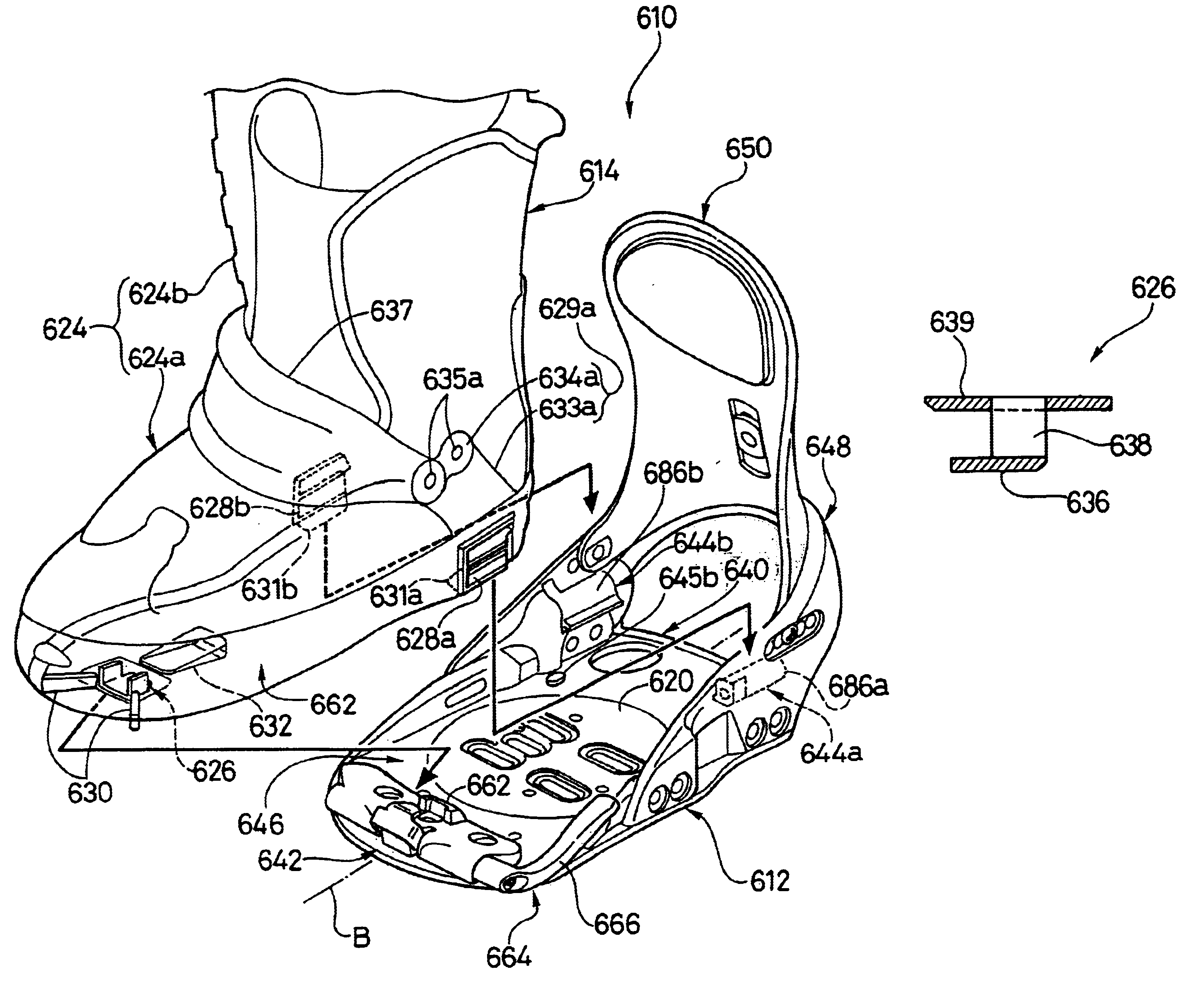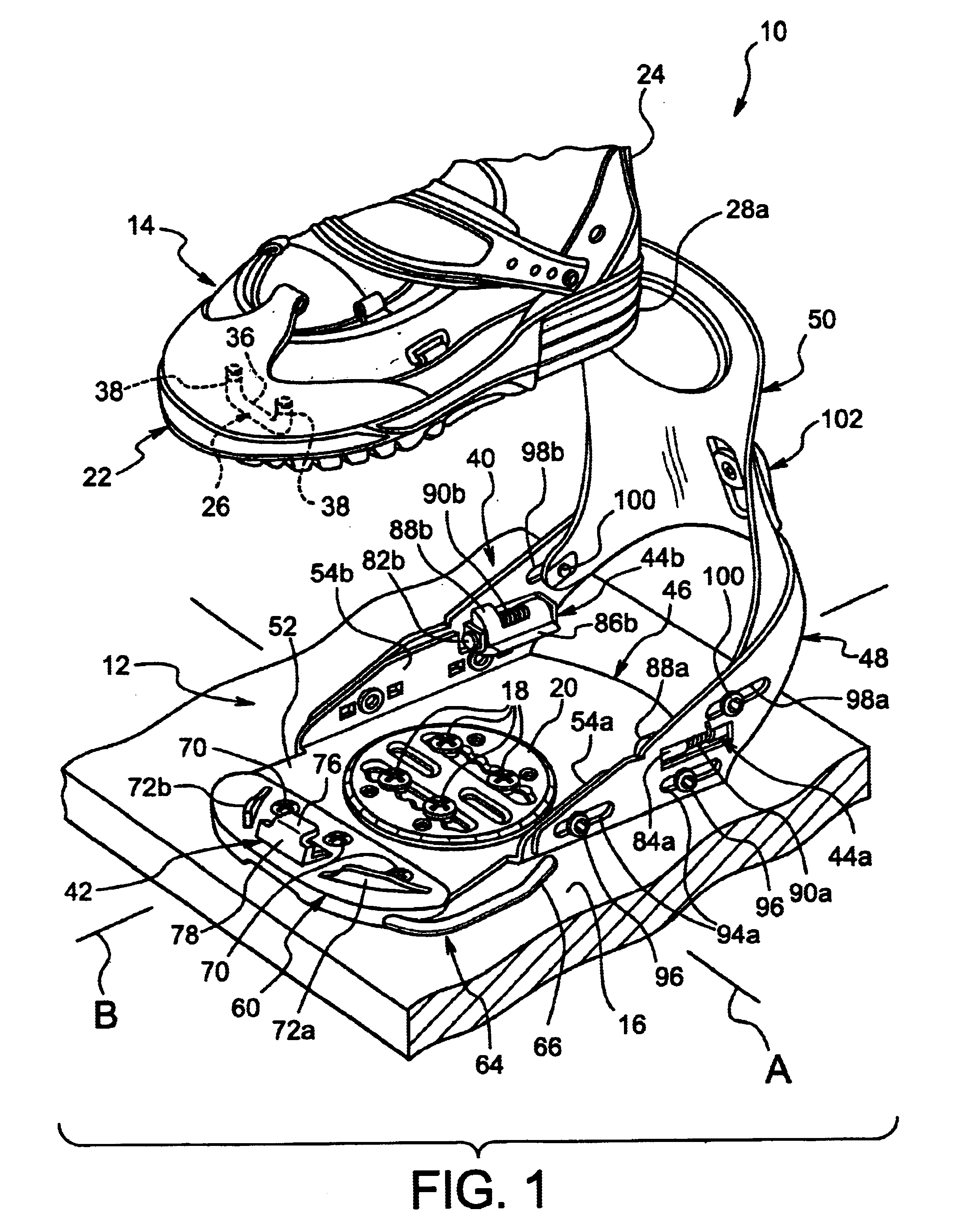Snowboard binding system
a technology of binding system and snowboard, which is applied in the direction of ski binding, snowboard binding, skiing, etc., can solve the problems of requiring a significant amount of effort, the knees not always straight when wearing inclined snowboard boots, and the inability of the snowboard to turn in the direction of the snowboard
- Summary
- Abstract
- Description
- Claims
- Application Information
AI Technical Summary
Benefits of technology
Problems solved by technology
Method used
Image
Examples
third embodiment
Referring now to FIG. 19, a snowboard binding 312 is illustrated in accordance with a third embodiment of the present invention. The snowboard binding 312 of this third embodiment is substantially identical to the snowboard binding 12 of the first embodiment except the snowboard binding 312 utilizes a base member 340 which is a modified version of the base member 40 of the first embodiment. The snowboard binding 312 is designed to be used with a snowboard boot identical or substantially identical to the snowboard boot 14 of the first embodiment. Since the snowboard binding 312 of this third embodiment is substantially identical to snowboard binding 12 of the first embodiment, the snowboard binding 312 will not be discussed or illustrated in detail herein. Rather, the following description will focus mainly on the differences. Moreover, it will be apparent to those skilled in the art that most of the descriptions of snowboard binding system 10, the snowboard binding 12 and the snowbo...
fourth embodiment
Referring now to FIG. 20, a portion of a snowboard binding system 410 is illustrated in accordance with a fourth embodiment of the present invention. The snowboard binding system 410 of this fourth embodiment is substantially identical to the snowboard binding system 10 of the first embodiment, except the snowboard binding system 410 includes a base member 440, which is a modified version of the base member 40 of the first embodiment. The snowboard binding system 410 has a snowboard binding 412, which is designed to be used with a snowboard boot identical or substantially identical to snowboard boot 14 of the first embodiment. Since the snowboard binding system 410 is substantially identical to snowboard binding system 10 of the first embodiment, the snowboard binding system 410 will not be discussed or illustrated in detail herein. Rather, the following description will focus mainly on the differences. Moreover, it will be apparent to those skilled in the art that most of the descr...
fifth embodiment
Referring now to FIGS. 21-45, a modified snowboard binding 512 and a modified snowboard boot 514 are illustrated in accordance with a fifth embodiment of the present invention. The snowboard binding 512 of this fifth embodiment is identical to the snowboard binding 12 of the first embodiment, except that the front binding arrangement of the snowboard binding 512 has been modified from the front binding arrangement of the snowboard binding 12 of the first embodiment as discussed below. Thus, the remaining parts of the snowboard binding 512 are identical to the snowboard binding 12 of the first embodiment. Since the snowboard binding 512 of the fifth embodiment is substantially identical to the snowboard binding 12 of the first embodiment, the snowboard binding 512 will not be discussed or illustrated in detail herein. Rather, the following description will focus mainly on the differences of the snowboard binding 512 from the snowboard binding 12. Moreover, it will be apparent to thos...
PUM
 Login to View More
Login to View More Abstract
Description
Claims
Application Information
 Login to View More
Login to View More - R&D
- Intellectual Property
- Life Sciences
- Materials
- Tech Scout
- Unparalleled Data Quality
- Higher Quality Content
- 60% Fewer Hallucinations
Browse by: Latest US Patents, China's latest patents, Technical Efficacy Thesaurus, Application Domain, Technology Topic, Popular Technical Reports.
© 2025 PatSnap. All rights reserved.Legal|Privacy policy|Modern Slavery Act Transparency Statement|Sitemap|About US| Contact US: help@patsnap.com



